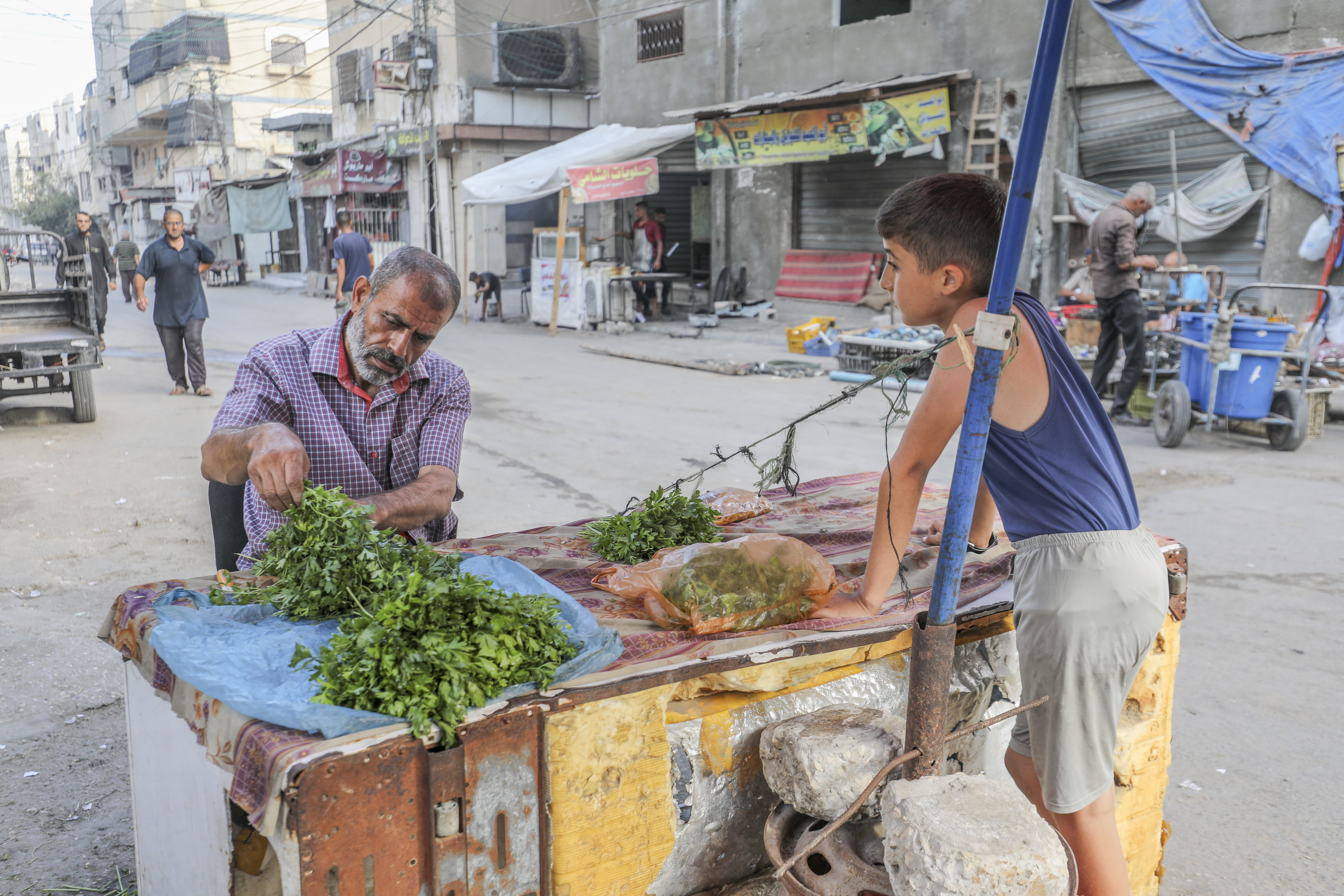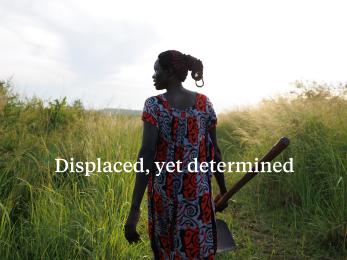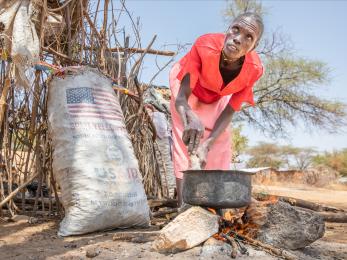Fighting hunger, one garden at a time

Elizabeth traces out a long, narrow bed in the red dirt and drives a small wooden stake into each of the four corners.
Her neighbors crowd around the plot — their new community garden — watching carefully. Most of them are young women, some pregnant or nursing infants.
Elizabeth hands one of the women a hoe and, between two of the stakes, she starts to turn the red earth. This hot day’s work is an investment in the health of the whole village. Soon this plot will overflow with nutritious vegetables, ripe for picking.
Feeding your family is a duty that transcends race, class and geographical barriers. Ensuring that her children eat — and eat as well as she can afford — is as important to Elizabeth as the lunchbox you carefully pack for your child.
However, this part of Uganda, the Karamoja region, has some of the highest poverty rates in the country. Uganda also has the fourth-highest fertility rate in the world (6.06 children born per woman), which makes for devastating results: widespread malnutrition and infant and maternal deaths.
That’s why it’s especially important we improve access to health care and nutritious food for mothers and children.
The problem is big, but we're introducing a simple solution: convenient and sustainable kitchen gardens. And the impact is transformative.
Growing change from the ground up
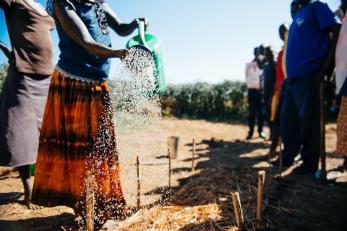
In the dry season, the sun beats down from a cloudless sky. It's a brutally hot day, so each person takes turns turning the dirt in the new garden bed. Elizabeth sprinkles a mixture of ash, charcoal and manure on each row, explaining to the crowd that this will make the soil better and the new plants healthier.
These gardens are powerful, because they harness resources the community already has: seeds, land, manure, ash, small amounts of water, and cooperative neighbors.
A local Mercy Corps worker in the village teaches the women the best ways to design, plant and grow their gardens. Altogether, it makes for a sustainable solution to the stubborn challenge of finding healthy food.
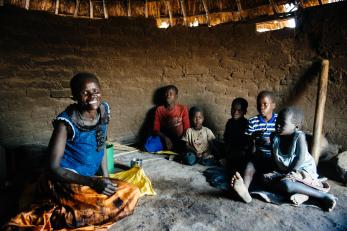
Elizabeth, a 40-year-old mother of eight, is this group’s leader mother, an important player in Mercy Corps’ efforts to improve health here. Through this program, we’ve taught Elizabeth key information to help improve the health of her community — everything from basic prenatal care to the design and use of sanitary facilities like drying racks and trash pits for the kitchen. We’ve also trained her in nutrition and gardening.
But the learning doesn’t end there. Elizabeth then passes her knowledge on to a group of 10 women in her village, amplifying our reach and leading by example in her community.
Elizabeth was already a pillar in her village when she entered our program, which is how she became a leader mother.
“I have a latrine, I have a kitchen, and I also have a kitchen garden behind," she says. "The criteria for the selection of leader mothers [is] they said they need someone who is exemplary in the community so that when I pass the message to the neighbor women, I have that confidence and they know that is what I do.”
Small improvements make a big impact

Uganda has a nutrition paradox. The country generally has plenty of food, but not a wide variety of it. There are epidemic levels of malnutrition because people tend to eat a very starchy diet based on beans, sorghum and millet — filling crops that are easy to grow and store.
Across Uganda, nearly 40 percent of children under 5 have stunted growth. This has profound consequences for health and cognitive development across a child’s whole lifetime.
It may not seem like small kitchen gardens can make a dent on a problem as big as nationwide chronic malnutrition, but Mercy Corps believes they are an important part of changing the dietary patterns here.
The day I visited, the neighbors were counting on Elizabeth’s gardening expertise so their communal gardens will provide fresh vegetables for their families soon.
I watched Elizabeth pull a handful of home-saved seeds for local greens and peanuts from her skirt, then demonstrate how to plant them in rows. The women mulched the ground with straw and threw handfuls of water onto the bed.
Sustainability and accessibility are the keys to the garden design Mercy Corps has introduced. Using saved seeds and fertilizers like chicken manure makes it possible to maintain the gardens with materials they have at hand.

“Now we are able to diversify the diet,” she told me. “We know if we have eaten beans today, tomorrow we can cook some vegetables.”
Elizabeth and her daughter led me into their own kitchen garden, a plot of land directly behind their kitchen hut. The family grows several varieties of greens I hadn’t seen before, in addition to peanuts and arrowroot.
Before these gardens, during the dry season, women had to forage for wild vegetables in the bush. It took hours. “We would leave early in the morning, by 6 or 7 to go and look for food," Elizabeth says. "We’d get up in the morning and we wouldn’t come back until noon or later.
“We didn’t know that we could also plant something very small at home where we can manage, and we can get vegetables out of it. It is a very good achievement. We are able to change our diet, our children are eating well, and their nutrition is a bit improved.”
A brighter tomorrow starts today

It took a few minutes for my eyes to adjust to the dark inside the kitchen hut while Elizabeth started a wood fire to cook. Her friend used two rocks to ground peanuts into smooth butter while Elizabeth boiled the greens.
In this basic kitchen, the two women put together a healthy lunch for five of Elizabeth’s children. She called the kids in to eat, and they settled on empty grain sacks on the dirt floor.
Elizabeth made sure each child washed their hands in a plastic bucket of water before the meal.
Then, lunch was served: yams and “pasted greens,” the mix of peanut butter and boiled greens that’s common in Uganda. The children were bright-eyed and ate their lunch without a moment’s hesitation.
Elizabeth said there is a hunger in the community for the kind of information Mercy Corps is spreading. It’s just one way we work to connect people to the resources they need to build a stronger tomorrow for their communities.
“We welcome the idea, and we are following it because I can see that there are fewer communal illnesses, like diarrhea and cough,” Elizabeth said. “We used to have a lot of sicknesses, there was malnutrition, but now the status has improved … There’s a very big change.”
